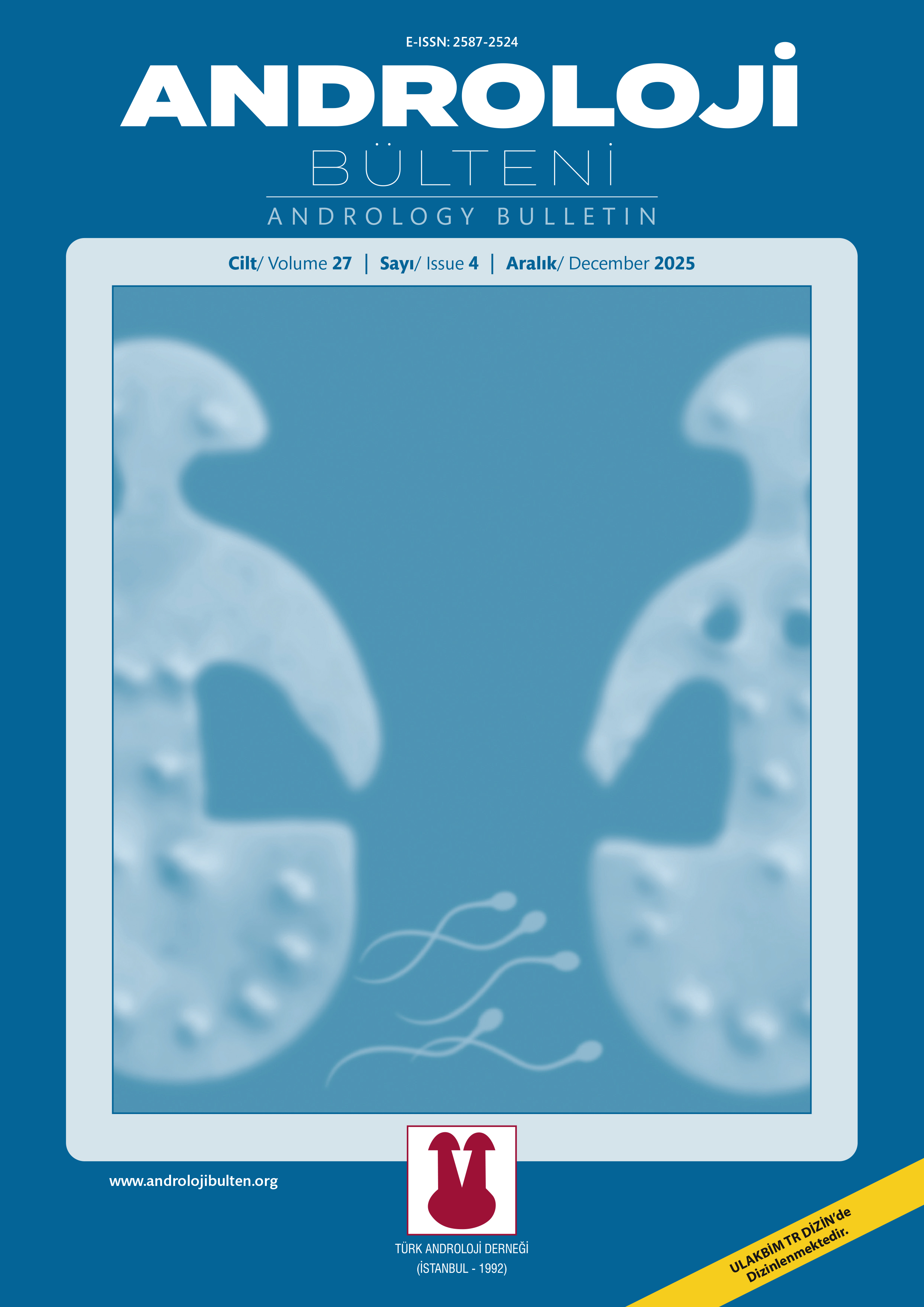
Bu derginin içeriği Creative Commons Atıf-GayriTicari 4.0 Uluslararası Lisansı kapsamında lisanslanmıştır.
Varikoseli olan hastalarda nötrofil/lenfosit oranı (NLR), platelet/ lenfosit oranı (PLR), monosit/eozinofil oranı (MER) gibi enflamatuvar belirteçlerin varikoselektomi sonrası spermiogram parametrelerinin değişimine etkisini öngörme
Murat Beyatlı1, Feyza Beyatlı2, Mehmet Duvarcı3, Aykut Demirci3, Fatih Hızlı3, Halil Basar31Sakarya Yenikent Devlet Hastanesi, Üroloji Kliniği, Sakarya, Türkiye2VM Medical Park Kocaeli Hastanesi, Kadın Hastalıkları ve Doğum Kliniği, Kocaeli, Türkiye
3Ankara Dr. Abdurrahman Yurtaslan Onkoloji Eğitim ve Araştırma Hastanesi, Üroloji Kliniği, Ankara, Türkiye
AMAÇ: Mikroskopik varikoselektomi (MV) yapılan hastalarda enflamatuvar kan belirteçleri kullanılarak ameliyat sonrası spermiogram parametrelerindeki değişimi tahmin etmektir.
GEREÇ ve YÖNTEMLER: Kliniğimizde MV yapılan 25 hasta çalışmaya dâhil edildi. Hemogram parametreleri ameliyattan hemen önce ve yirmi gün sonra, spermiyogram parametreleri ise ameliyattan altı ay sonra ölçüldü. Hastalar iki gruba ayrıldı. Ameliyat sonrası Toplam Hareketli Sperm Sayısında (TMS) >%50 iyileşme olan hastalar iyileşen hasta grubuna, %50’den az iyileşme olan hastalar ise iyileşmeyen hasta grubuna dâhil edildi. Nötrofil/lenfosit (NLR), trombosit/lenfosit (PLR), monosit/ eozinofil (MER) oranları gruplar arasında karşılaştırıldı.
BULGULAR: Ameliyat sonrası NLR’de istatistiki olarak anlamlı düşüş olan hastalarda TMS’de iyileşme olduğu görülmüştür (p=0,009). Nötrofil/lenfosit değişimi için elde edilen cut-off noktası %1,06 ve üzeri olarak saptanmıştır. Trombosit/lenfosit ve MER parametreleri ise TMS’nin iyileşmesini öngörmede istatistiki olarak anlamlı değildir (p>0,05). Ameliyat sonrasında TMS’de iyileşme olan hastalarda ameliyat öncesi nötrofil ve monosit sayıları daha yüksek bulundu ve bu parametreler için cut-off değerleri sırasıyla 3,77 ve 0,47 olarak tespit edildi (p<0,05).
SONUÇ: NLR, nötrofil veya monosit değerlerinin ameliyat öncesi ve sonrası sonuçları TMS’de iyileşmeyi öngörmede bir belirteç olarak kullanılabilir.
Anahtar Kelimeler: varikosel, NLR, PLR, MER, enflamasyon
Prediction of the effect of inflammatory markers such as neutrophil/lymphocyte ratio (NLR), platelet/lymphocyte ratio (PLR), monocyte/eosinophil ratio (MER) on changes in spermiogram parameters after varicocele surgery
Murat Beyatlı1, Feyza Beyatlı2, Mehmet Duvarcı3, Aykut Demirci3, Fatih Hızlı3, Halil Basar31Department of Urology, Sakarya Yenikent State Hospital, Sakarya, Turkey2Department of Gynecology and Obstetrics, VM Medical Park Kocaeli Hospital, Kocaeli, Turkey
3Department of Urology, Ankara Dr.Abdurrahman Yurtaslan Onkoloji Training and Research Hospital, Ankara, Turkey
OBJECTIVE: In this study, we aimed to predict the changes in postoperative spermiogram parameters in patients who underwent varicocelectomy by using pre- and post-operative hemogram parameters and inflammatory blood markers.
MATRERIAL and METHODS: 25 patients who underwent microscopic varicocelectomy in our clinic and met the study criteria were included in the study. Hemogram parameters were measured just before and twenty (20) days after the surgery, and spermiogram parameters were measured 6 months after the surgery. The patients seperated into two groups. Patients with >50% improvement in postoperative Total Motile Sperm Count (TMS) were included in the recovered patients group, and patients with less than 50% improvement were included in the non-recovered patients group. Neutrophil / lymphocyte ratio (NLR), platelet / lymphocyte ratio (PLR), monocyte / eosinophil ratio (MER), and blood counts such as neutrophil, lymphocyte, platelet, monocyte, eosinophil were compared in groups, also were compared before and after surgery, separate
RESULTS: Improvement in TMS was observed in patients with a statistically significant decrease in postoperative NLR (p = 0.009; p <0.01). As a result of the calculations, cut-off point for the NLR change was accepted as 1.06% and above. PLR and MER parameters were not statistically significant in predicting the improvement of TMS. Among the neutrophil, lymphocyte, platelet, monocyte, eosinophil counts, preoperative neutrophil and preoperative monocyte counts were found to be higher in patients with postoperative TMS improvement. Cut-off points for these preoperative neutrophil and monocyte counts were calculated as 3.77 and 0.47, respectively. In our study, we could not reach any statistically significant result for lymphocyte, eosinophil and platelet counts.
CONCLUSION: Preoperative and postoperative results of NLR, neutrophil or monocyte counts can be used as a marker to predict improvement in TMS.
Keywords: varicocele, NLR, PLR, MER, inflammation
Makale Dili: Türkçe
(495 kere indirildi)













